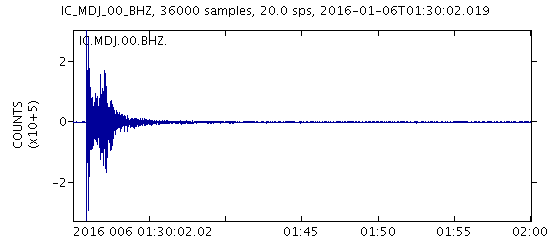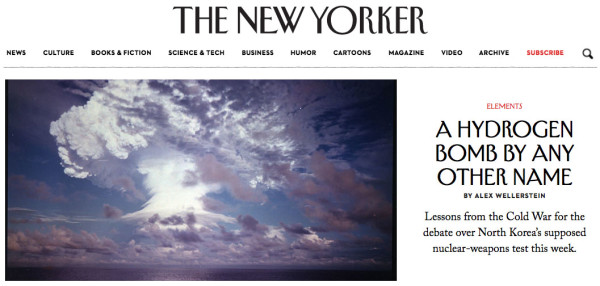This past week and this next week are the last of my winter break before the new semester starts, which in the true fashion of academia means I am more busy than I usually am trying to cram as much non-teaching “work” into every day as possible. North Korea’s test of a nuclear weapon earlier this week, of course, just added to the workload. Thanks, Kim Jong-un. I am behind on my annual Nuclear History Bibliography, but it is coming, soon. NUKEMAP usage has been about 10X higher than normal — over 300,000 users last week.
I have written up a piece for the New Yorker’s Elements blog on the historical-technical-political dimensions of calling something a “hydrogen bomb,” or disputing it, that went up yesterday. I also talked a bit to Business Insider about how the true “Teller-Ulam design” of a thermonuclear weapon is not merely a single bomb design but an entire system of designing a getting of possible effects — so one ought not necessarily be expecting the North Koreans to make something that looks like Ivy Mike, Castle Bravo, or, god forbid, the Tsar Bomba. The North Koreans themselves, in their official statement (a wild read in and of itself), claimed that the “technological specifications of the newly developed H-bomb for the purpose of test were accurate and scientifically verified the power of smaller H-bomb” — a lot of little qualifications that seem to be saying, “we’re trying for miniaturization, not high yields, and this was a scientific test of a principle, not of a full-yield warhead.”
Given their strategic situation, a smaller bomb would make a whole lot more sense than something the size of a school bus. And I would note that the tendency to test all weapons at full power (or even more than the projected yield) is something that, while characteristic of the American program, is not necessarily the only way to do things. (The Soviets typically tested large bombs at half-power, on purpose.)

The seismic waveform of the 2016 North Korean nuclear test, as detected by a station in Mudanjian, China. Click here to listen to it rendered as audio. Source: Incorporated Research Institutions for Seismology.
Which is just to say, I don’t think we (at least those of us in the unclassified world) quite have enough information to really parse out what the North Koreans were trying to do in that test. The yield estimates coming out — ranging from 6 to 30 kilotons or so — don’t sound like much, in and of themselves. But there’s still a lot we don’t know, and might not know. 1
Somewhere in between hysterically overestimating North Korea’s capabilities and smugly underestimating them is some sort of middle ground, a place where we need to acknowledge that this is 60-year-old technology, and the sheer technical difficulty alone is probably not going to stop them from becoming a fully-fledged nuclear power.
- And there are also ways to reduce the seismic signature of nuclear tests — like setting off a test in the cavern created by a previous test. It isn’t clear what incentive North Korea would have in making their tests look smaller than they actually were, but, then again, there is much about their thinking that is not intuitive to those of us on the outside. So I’m not sure that’s a likely scenario, but I don’t think it can be ruled out as impossible.[↩]



Great post, as always!
I enjoyed reading your post, and your related articles, and I wanted to add just one thing: there may be a political debate on what should be called an H-bomb, but I think that only Teller-Ulam designs should be given that name (or the name thermonuclear bomb). the other designs are of course possible, but they don’t come close to the efficiency or yield-potential of Teller-Ulam bombs.
Also, in the 60 years that have past, no one came with a better idea on how to use fusion (as far as we know…). You refer to the Teller-Ulam design as a system of designing bombs- but what are the variants here? I’m not talking about improvements in the design, but on making major changes in the principles of the design.
But as always, Great post, and keep going with your work here, it is always very interesting to read 🙂
What I gather from reading accounts of weaponeers and testing regarding Teller-Ulam are two things. One is that there is no universally agreed-upon definition of exactly what constitutes that — radiation implosion, sure, but there are other systems (like the Fuchs-von Neumann patent) that use radiation implosion but are not Teller-Ulam. High compression, sure. (Sloika does this too, though.) There are apparently a variety of modes of working with the question of radiation transport, of what you can do with that radiation from the point of view of a designer. Some of the breakthroughs in miniaturization in the US programs of the early 1960s were described as creating a whole new set of possibilities, more “radiation engineering” than “radiation implosion.” There are ways you can play with the geometries that seem to get well beyond what Teller and Ulam were up to, and even Teller and Ulam themselves disagreed on what constituted their “invention.” The line between “improvement” and “major changes” is going to be an inherently arbitrary one and will depend on who you ask.
Which is just to say… any sufficiently complicated technical creation is going to have these kinds of definition issues. Questions about the status of the invention in question are always at the heart of priority disputes, for example. The addition of secrecy and political stakes (what is and isn’t an H-bomb ties into other political questions in the mid-1950s, as does who gets credit) further muddies the waters. My interest is not in arbitrating these nomenclature disputes, but in trying to look at what lies behind them, why we bother to fight over them in the first place.
Hi Alex,
This closely corresponds to my view on the situation.
I tend to view the UT design as three distinct phenomena. The NoKo guys have to show ability to control (or at least explore) all three. They should be able to make three very peculiar plots, if they can do that – they can be treated for all practical purposes as a TN-capable entity. (FWIW – I don’t think they are anywhere close to this – they haven’t done anywhere near the testing they need to do to make those kinds of plots).
If their claims of success are to be taken seriously – they will have to publish close in measurements like the Indian did in 1998.
At this time I am against any military maneuver as it may destabilize the situation in unpredictable ways. That said if the SoKo navy does not shore up the NLL with additional policing resources ASAP – it will invite criticism in the future.
IMO absent artful diplomacy – the NLL will go alive soon.
Why did the Soviets typically test at half-power? Were there any benefits to this?
I knew that Tsar Bomba was tested at something about half power, didn’t know they did this though as a regular method of testing.
When you look at their early testing record, they seemed much more content with scaled-down versions than the US, who went, in its early thermonuclear work, with the biggest blasts possible. Possibly this was an attempt to reduce fallout (you swap out the uranium in the secondary with lead), possibly this just reflected a different testing culture, possibly this was the result of them testing “domestically” (Kazakh SSSR) as opposed to “in the middle of the ocean” (Pacific Proving Grounds), I don’t know. But it’s a different testing culture, and that has some relevance for thinking about the testing culture of North Korea — we should not assume they see these tests in the same way we do.
“Dumbing down” the final stage of a Teller-Ulam design by swapping its intended fissible tamper with a non fissible one (ie. replacing uranium by lead) produces half yied while still proving a design implentation.
The Yield second half would come from the [last stage] tamper fission induced by the [last stage] fusion fast neutrons. While producing twice as much yield, this would also produce a lot more fallout (the fission products of that last tamper).
It is therefore preferable to stay at half yield when testing the device on your own soil with civilian downwind. This might be different when operating from an atoll in the middle of the Pacific Ocean.
I’m fairly sure I read about this on the blog, but I’m unable to find any article mentionning it. So wikipedia will be the source: https://en.wikipedia.org/wiki/Tsar_Bomba#Background 3rd paragraph.
This is the unfolding of historical decisions. Seventy years ago, the USA chose to build a nuclear arsenal rather than agree to control such weapons and the wars in which they might be used. The nuclear arms race and the proliferation of nuclear weapons was predicted at that time, most notably in the Szilard petition and the Franck Report.
When the Brits were trying to demonstrate a mastery of nuclear weapons (to the U.S., so that information sharing would resume), they were a bit obsessed with the 1MT level. If your bomb was >1MT, then it was definitely a “real” h-bomb. Anything less wasn’t a fully convincing demo.
The US scientists had similar debates internally when it came to fulfilling the requirement to produce a “hydrogen bomb” in the early 1950s. When you don’t know what you’re searching for — other than “large” — it’s a funny political requirement.
(In theory, the Soviets thought you could scale a Sloika up to 1 Mt or so, as an aside. The US was able to produce half a megaton with pure fission alone, so perhaps this isn’t that surprising.)
I had a sudden thought. Where does North Korea get it’s uranium from? Do they mine it, or rely on shipments from elsewhere?
They mine it locally at this point.
Also, if they’re actually boosting with DT gas, where does the tritium come from?
Apparently they have an operational reactor that they could be using to breed it.